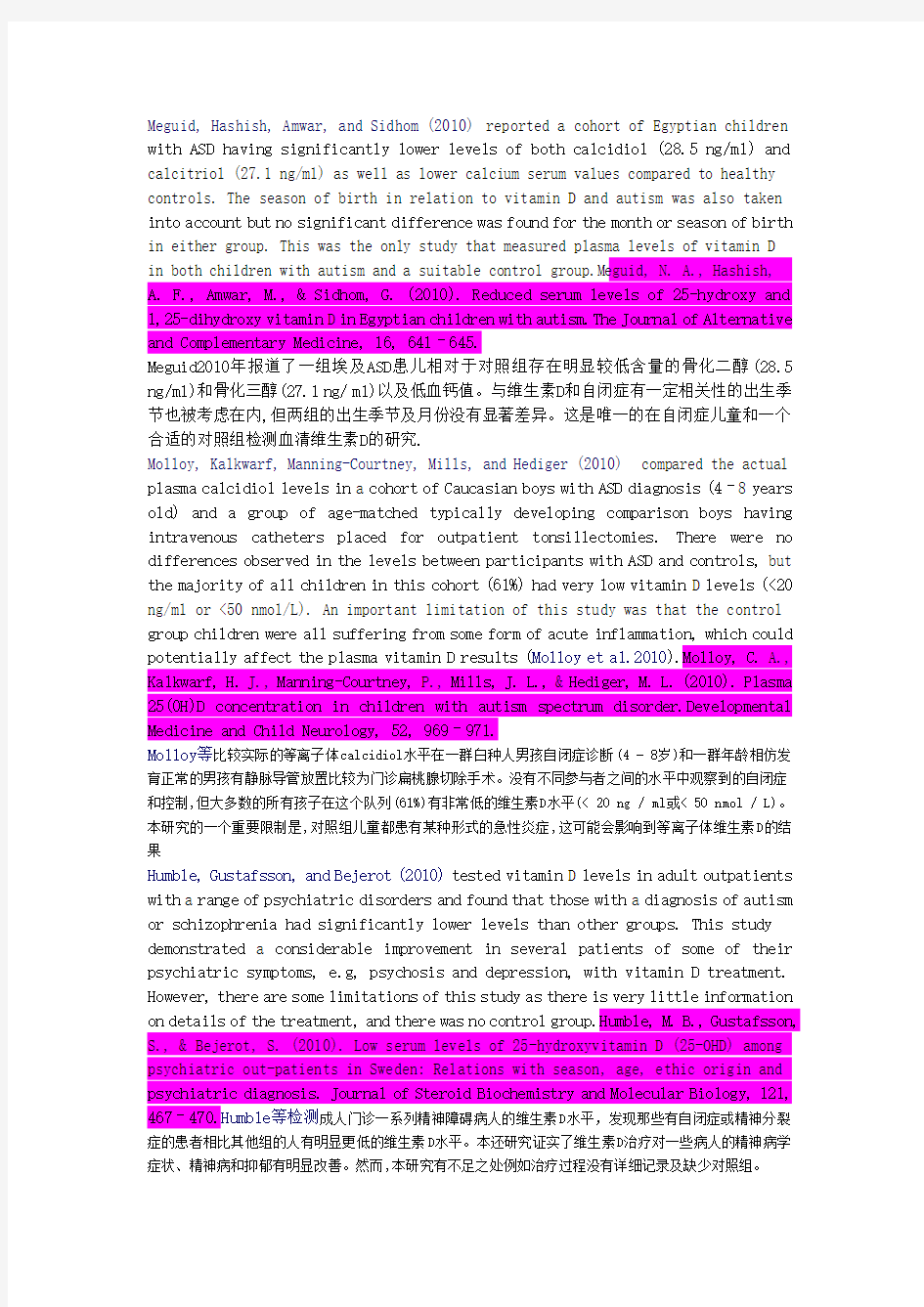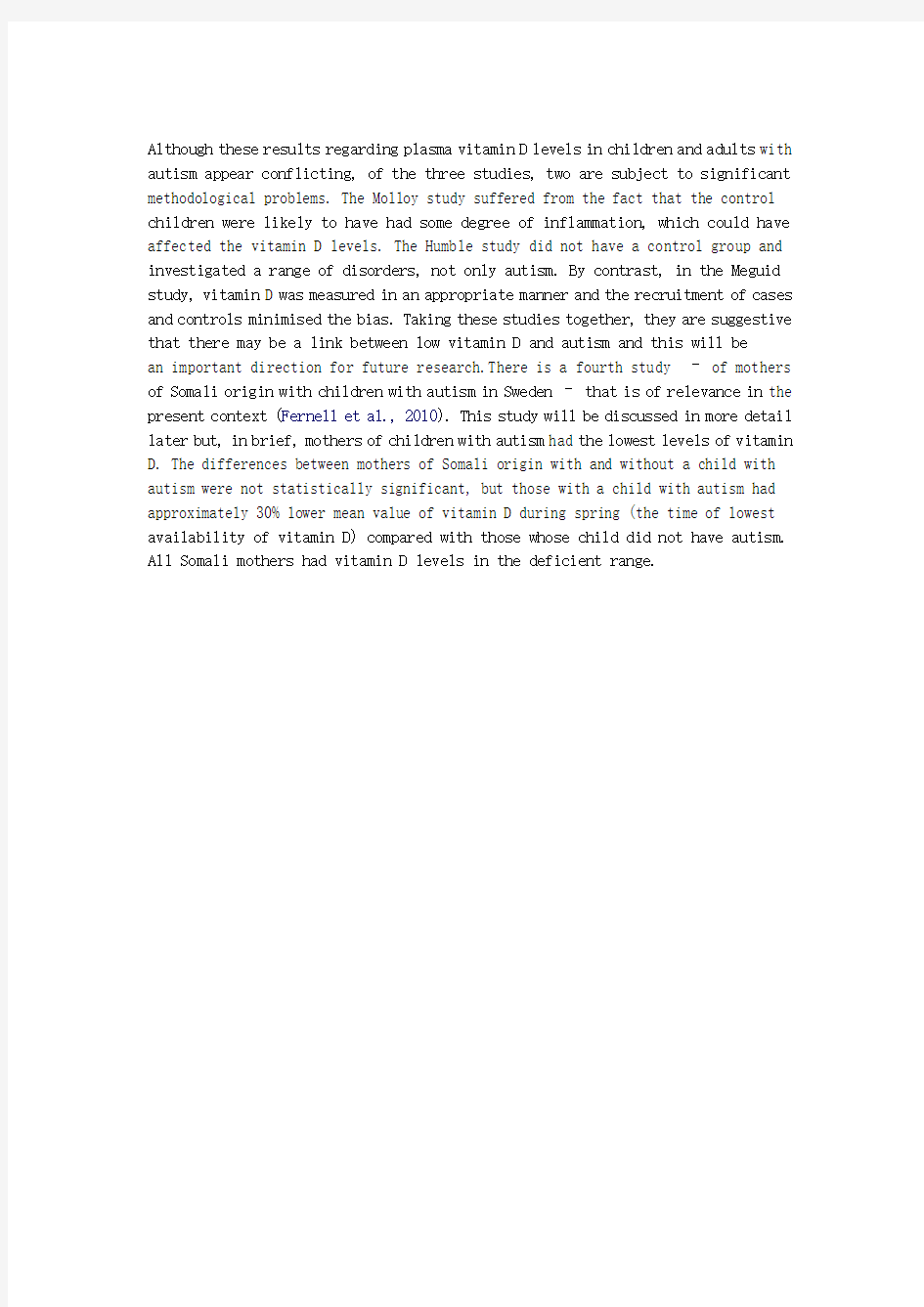创伤


Meguid, Hashish, Amwar, and Sidhom (2010) reported a cohort of Egyptian children with ASD having significantly lower levels of both calcidiol (28.5 ng/ml) and calcitriol (27.1 ng/ml) as well as lower calcium serum values compared to healthy controls. The season of birth in relation to vitamin D and autism was also taken into account but no significant difference was found for the month or season of birth in either group. This was the only study that measured plasma levels of vitamin D in both children with autism and a suitable control group.Meguid, N. A., Hashish, A. F., Amwar, M., & Sidhom, G. (2010). Reduced serum levels of 25-hydroxy and 1,25-dihydroxy vitamin D in Egyptian children with autism.The Journal of Alternative and Complementary Medicine, 16, 641–645.
Meguid2010年报道了一组埃及ASD患儿相对于对照组存在明显较低含量的骨化二醇(28.5 ng/ml)和骨化三醇(27.1 ng/ ml)以及低血钙值。与维生素D和自闭症有一定相关性的出生季节也被考虑在内,但两组的出生季节及月份没有显著差异。这是唯一的在自闭症儿童和一个合适的对照组检测血清维生素D的研究.
Molloy, Kalkwarf, Manning-Courtney, Mills, and Hediger (2010) compared the actual plasma calcidiol levels in a cohort of Caucasian boys with ASD diagnosis (4–8 years old) and a group of age-matched typically developing comparison boys having intravenous catheters placed for outpatient tonsillectomies. There were no differences observed in the levels between participants with ASD and controls, but the majority of all children in this cohort (61%) had very low vitamin D levels (<20 ng/ml or <50 nmol/L). An important limitation of this study was that the control group children were all suffering from some form of acute inflammation, which could potentially affect the plasma vitamin D results (Molloy et al.2010).Molloy, C. A., Kalkwarf, H. J., Manning-Courtney, P., Mills, J. L., & Hediger, M. L. (2010). Plasma 25(0H)D concentration in children with autism spectrum disorder.Developmental Medicine and Child Neurology, 52, 969–971.
Molloy等比较实际的等离子体calcidiol水平在一群白种人男孩自闭症诊断(4 - 8岁)和一群年龄相仿发育正常的男孩有静脉导管放置比较为门诊扁桃腺切除手术。没有不同参与者之间的水平中观察到的自闭症
和控制,但大多数的所有孩子在这个队列(61%)有非常低的维生素D水平(< 20 ng / ml或< 50 nmol / L)。
本研究的一个重要限制是,对照组儿童都患有某种形式的急性炎症,这可能会影响到等离子体维生素D的结
果
Humble, Gustafsson, and Bejerot (2010) tested vitamin D levels in adult outpatients with a range of psychiatric disorders and found that those with a diagnosis of autism or schizophrenia had significantly lower levels than other groups. This study demonstrated a considerable improvement in several patients of some of their psychiatric symptoms, e.g, psychosis and depression, with vitamin D treatment. However, there are some limitations of this study as there is very little information on details of the treatment, and there was no control group.Humble, M. B., Gustafsson, S., & Bejerot, S. (2010). Low serum levels of 25-hydroxyvitamin D (25-OHD) among psychiatric out-patients in Sweden: Relations with season, age, ethic origin and psychiatric diagnosis. Journal of Steroid Biochemistry and Molecular Biology, 121, 467–470.Humble等检测成人门诊一系列精神障碍病人的维生素D水平,发现那些有自闭症或精神分裂
症的患者相比其他组的人有明显更低的维生素D水平。本还研究证实了维生素D治疗对一些病人的精神病学
症状、精神病和抑郁有明显改善。然而,本研究有不足之处例如治疗过程没有详细记录及缺少对照组。
Although these results regarding plasma vitamin D levels in children and adults with autism appear conflicting, of the three studies, two are subject to significant methodological problems. The Molloy study suffered from the fact that the control children were likely to have had some degree of inflammation, which could have affected the vitamin D levels. The Humble study did not have a control group and investigated a range of disorders, not only autism. By contrast, in the Meguid study, vitamin D was measured in an appropriate manner and the recruitment of cases and controls minimised the bias. Taking these studies together, they are suggestive that there may be a link between low vitamin D and autism and this will be
an important direction for future research.There is a fourth study – of mothers of Somali origin with children with autism in Sweden – that is of relevance in the present context (Fernell et al., 2010). This study will be discussed in more detail later but, in brief, mothers of children with autism had the lowest levels of vitamin D. The differences between mothers of Somali origin with and without a child with autism were not statistically significant, but those with a child with autism had approximately 30% lower mean value of vitamin D during spring (the time of lowest availability of vitamin D) compared with those whose child did not have autism. All Somali mothers had vitamin D levels in the deficient range.
